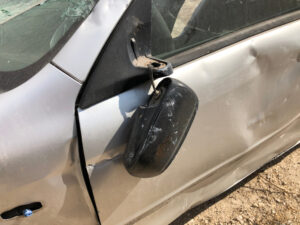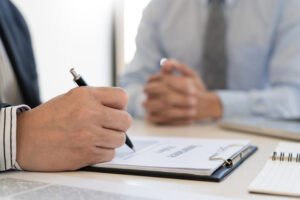T-bone accidents typically occur when other drivers fail to yield the right-of-way to other vehicles or commit other road-rule violations at traffic intersections. If you suffered injuries in a T-bone accident that a negligent driver caused, you may have legal options available.
A skilled car accident attorney in your area can review the police report in your case, retain an accident reconstructionist, or take other measures to investigate the cause and circumstances surrounding your accident. Your Phoenix car accident attorney can then file a claim with the responsible driver's insurance company or pursue various litigation options in court on your behalf.
How Drivers Cause T-bone Accidents
T-bone accidents, also known as side-impact collisions, can occur due to the actions of other drivers in various locations. One common scenario unfolds at intersections when drivers fail to yield the right-of-way. For instance, a driver running a red light or disregarding a stop sign may collide with the side of another vehicle lawfully proceeding through the intersection. This failure to adhere to traffic signals significantly contributes to T-bone accidents.

Distracted driving also plays a significant role in T-bone accidents, particularly at intersections or in parking lots. Drivers who engage in activities like texting, talking on the phone, or adjusting navigation systems may fail to notice oncoming traffic. As a result, they may enter an intersection without being fully aware of their surroundings, leading to T-bone collisions with vehicles lawfully proceeding through the intersection.
In addition, reckless driving behaviors, such as speeding or aggressive driving, contribute to T-bone accidents. Drivers who exceed speed limits or tailgate other vehicles increase the risk of colliding with the side of another car, especially in situations where abrupt stops or turns are necessary.
In parking lots, improper backing maneuvers often lead to T-bone accidents. Drivers backing out of parking spaces without adequately checking for oncoming traffic can collide with vehicles in the parking aisle. This type of T-bone accident frequently occurs in crowded parking lots with restricted visibility.
In residential areas, drivers failing to yield at uncontrolled intersections or disobeying right-of-way rules can cause T-bone accidents. The lack of traffic signals or signs necessitates a heightened awareness of other drivers, and failure to exercise caution can result in broadside collisions.
Weather conditions also play a role in T-bone accidents. In adverse weather, such as heavy rain or snow, drivers may struggle to maintain control of their vehicles. Slipping on wet or icy roads can lead to T-bone collisions, especially when drivers cannot stop or maneuver effectively.
Other drivers can cause T-bone accidents in various locations by failing to yield at intersections, engaging in distracted driving, reckless driving behaviors, improper backing maneuvers in parking lots, disregarding right-of-way rules in residential areas, and struggling to navigate adverse weather conditions. Vigilance, adherence to traffic laws, and cautious driving behaviors are essential in preventing T-bone accidents and ensuring overall road safety.
What Are the Most Common Injuries in T-bone Accidents?
Victims of T-bone accidents, also known as side-impact collisions, commonly suffer a range of injuries due to the unique dynamics of these crashes. Some common side-impact accident injuries include the following:
- Whiplash — One prevalent injury is whiplash, resulting from the abrupt side-to-side motion upon impact. The forceful jolt can strain the neck muscles and ligaments, causing pain, stiffness, and potential long-term complications.
- Chest Injuries — Chest injuries are also common, especially for occupants on the side of the impact. The abrupt force can cause contusions, rib fractures, or more severe internal injuries if the chest strikes the door or other interior surfaces. Chest injuries can be particularly serious, affecting respiratory function and necessitating immediate medical attention.
- Fractures and Broken Bones — Fractures and broken bones often result from the substantial force involved in T-bone accidents. An impact on the side of the vehicle can lead to broken arms, legs, hips, or pelvis, depending on the point of contact. These fractures may require surgical intervention and extensive rehabilitation for recovery.
- Spinal Injuries — Spinal injuries are a significant concern in T-bone accidents, with the forceful impact potentially causing damage to the spine. Herniated discs, fractures, or even spinal cord injuries may occur, resulting in varying degrees of paralysis or long-term disability.
- Soft Tissue Injuries — Soft tissue injuries, including bruises, sprains, and strains, are also prevalent due to the sudden and forceful movements during a T-bone collision. These injuries can cause pain, swelling, and prolonged recovery periods, affecting the victim's overall well-being.
- Head Injuries— Head injuries are frequent in T-bone accidents, particularly when the impact leads to the driver’s or passenger’s striking their head against the window, door, or other parts of the vehicle. Concussions, lacerations, or more severe traumatic brain injuries may occur, varying in severity based on the intensity of the collision.
- Psychological Injuries — Psychological injuries, such as post-traumatic stress disorder (PTSD), are also common in T-bone accidents. The sudden, unexpected nature of side-impact collisions can lead to persistent anxiety, flashbacks, and difficulty coping with the emotional trauma of the accident.
Victims of T-bone accidents commonly suffer a range of injuries, including whiplash, chest injuries, fractures and broken bones, spinal injuries, soft tissue injuries, head injuries, and psychological injuries such as PTSD. The severity of these injuries depends on various factors, including the speed and angle of the collision, the point of impact, and the use of safety features like seat belts and airbags. Seeking prompt medical attention and consulting with healthcare professionals are essential steps for managing and addressing the diverse injuries associated with T-bone accidents.
How Legally to Prove a T-bone Accident Using Various Pieces of Evidence

Legally proving a T-bone accident requires a comprehensive collection of evidence that establishes the circumstances surrounding the collision. Tangible evidence plays a crucial role in building a robust case. Types of evidence include all the following:
- Police Report — First, obtaining the police report is essential. This official document details the responding officer's observations, statements from involved parties and witnesses, and their preliminary assessment of fault. It provides a foundation for understanding the dynamics of the accident and can be valuable evidence in court.
- Eyewitness Accounts — Eyewitness accounts are instrumental in corroborating facts and providing additional perspectives on the T-bone accident. Collecting statements from individuals who witnessed the collision helps establish a more comprehensive and accurate picture of the events leading up to and during the accident.
- Photographs and Videos — Photographs and videos taken at the accident scene are also powerful evidence. They visually document vehicle damage, road conditions, traffic signals, and other relevant details. These visuals can provide critical context and support the victim's version of events, offering tangible proof of the impact's severity and the vehicles' positioning.
- Physical Evidence — Skid marks and other physical evidence on the road can offer insights into the dynamics of the T-bone accident. Analysis of these marks can help reconstruct the sequence of events and provide valuable information about the speeds, braking, and overall vehicle movements leading up to the collision.
- Damage Assessments and Repair Estimates — Vehicle damage assessments and repair estimates are tangible proof of the impact's force. Photographs of the damage, repair bills, and expert opinions can demonstrate the extent of the harm inflicted on the victim's vehicle, reinforcing the severity of the T-bone collision.
- Signal Timings and Intersection Design — Traffic signal timings and intersection design plans can be crucial in establishing liability. If the T-bone accident occurred at an intersection, the timing of traffic signals and any deviations from standard designs may contribute to the victim's case.
- Medical Records — Medical records documenting injuries sustained in the T-bone accident are other vital pieces of evidence. They establish a direct link between the collision and the victim's physical well-being, supporting claims for compensation related to medical expenses, pain and suffering, and other damages.
Legally proving a T-bone accident involves a strategic compilation of tangible evidence. Police reports, eyewitness accounts, photographs, videos, skid marks, vehicle damage assessments, traffic signal timings, intersection design plans, and medical records collectively build a compelling case. This multifaceted evidence reinforces the victim's version of events, strengthens liability claims, and forms the basis for seeking just compensation for the damages suffered in the T-bone accident.
Recovering Compensation for Injuries in T-bone Accident Cases
Recovering compensation after a T-bone accident involves pursuing various categories of damages to address the extensive losses the victim has incurred. Medical expenses represent a significant component of compensation, encompassing costs related to hospitalization, surgeries, medications, rehabilitation, and any other necessary medical treatments resulting from injuries sustained in the T-bone accident. Comprehensive documentation of these expenses is crucial to ensuring full reimbursement.

Property damage compensation addresses the costs of repairing or replacing the victim's vehicle and any other damaged property. This includes expenses such as towing, vehicle repairs, and temporary transportation during the repair process. Thorough assessment and documentation of property damage help determine the appropriate compensation to restore the victim to their pre-accident state.
Economic damages extend beyond medical expenses and property damage, covering the victim's various tangible losses. An accident victim can pursue lost earnings compensation for income lost during the recovery period, reflecting the income the victim would have earned if not for the T-bone accident. Additionally, the victim can seek loss of earning capacity if the injuries result in a diminished ability to earn income in the future, considering long-term career repercussions and financial consequences.
A T-bone accident victim may also pursue punitive damages in cases where the conduct of the at-fault party causing the T-bone accident is particularly egregious. Unlike compensatory damages that aim to restore the victim to their pre-accident state, punitive damages serve as punishment and deterrence. They intend to discourage similar behavior and hold the negligent party accountable for their recklessness or intentional misconduct.
Meticulously documenting and quantifying these damages to build a compelling case for compensation is imperative. An accident victim may use medical records, invoices, repair estimates, pay stubs, and expert opinions to establish the extent of the losses suffered in the T-bone collision.
Recovering compensation for a T-bone accident involves pursuing damages for medical expenses, property damage, economic losses such as lost earnings and loss of earning capacity, and, in certain cases, punitive damages. Thorough documentation and presentation of the extent of these damages are crucial in seeking fair and just compensation that adequately addresses the victim's losses and holds the at-fault party accountable for their actions.
Litigating T-bone Accident Cases Successfully
Victims of T-bone accidents resulting from another driver's negligence have various litigation options available to seek compensation for their damages. One primary avenue is filing a personal injury lawsuit against the negligent driver. This legal action seeks to establish the driver's liability for the T-bone accident and holds them accountable for the resulting injuries and damages.
In cases where the negligent driver acted within the scope of their employment, victims may explore litigation against the driver's employer through a vicarious liability claim. This legal approach holds employers responsible for their employees' actions during work-related activities, potentially expanding the available sources of compensation.
In certain situations, governmental entities responsible for road safety may be liable through a premises liability claim. If inadequate signage, faulty traffic signals, or poorly designed intersections contributed to the T-bone accident, victims can pursue litigation against the relevant government agency.
Another option is to negotiate a settlement through alternative dispute resolution methods, such as mediation or arbitration. These processes offer a collaborative, less adversarial approach to resolving T-bone accident disputes. A neutral third party facilitates discussions to reach a mutually agreeable settlement between the parties involved.
Regardless of the chosen litigation option, victims should consult a qualified car accident attorney to assess the viability of their case and determine the most appropriate legal strategy. Legal professionals can provide guidance on the specific elements required to build a compelling case, assist in gathering evidence, and navigate the complexities of the legal process to secure just compensation for the victims of T-bone that another driver's negligence caused.
Call an Experienced Car Accident Lawyer Near You Today

If you sustained injuries in a T-bone accident that a negligent driver or other negligent party caused, a skilled car accident attorney in your area can review your litigation options with you and select the proper course of action for your case. Your attorney can file a lawsuit in your case or litigate your case to a resolution in the state court system efficiently.